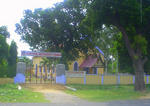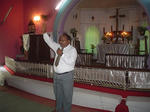Methodist Church in India
A History
The Methodist Church was founded by John Wesley, an Anglican Priest (1703 – 1791). The disciples of John Wesley followed a strict pattern of life and therefore they were called ‘Methodists’. for further details read http://en.wikipedia.org/wiki/Methodism#Other_countries
In 1870 William Taylor a famous evangelist was invited to India to hold special revival meetings. This visit of William Taylor changed the course of Methodism in India and led the Church out of its provincial boundaries and made it a national factor.In 1870 the first missionaries of the Women’s Foreign Missionary Society of the Methodist Episcopal Church came to India. Two young ladies Isabella Thoburn (an educationist) and Clara Swain (a doctor) were the women missionaries to reach India.
Evangelist work in Northern India led to the baptism of a large number of people. Thus started Mass Movement work, which brought several hundreds of thousands of converts into Methodist Church in the rural areas. In 1930 the Central Conference of Southern Asia elected Jaswant Rao Chitamber, the first national Bishop, marking the beginning of a new era.
Since 1928 the Methodist Church was engaged in negotiations with other Churches in North India to enter into organic union. The final agreed plan of Church Union in North India was prepared by 1966. This plan was commended to the Annual Conference of the Methodist Church of South Asia by the Central Conference in 1968. Even though the Annual Conference accepted the plan by more than two – third majority the Special Session of the Central Conference in 1970 opposed it as per the ruling by the Judicial Council of the Methodist Church.
The Central Conference of 1972 appointed a committee to continue negotiations with the newly formed Church of North India. The Central Conference of 1976 then resolved to consider the status of an affiliated autonomous Methodist Church in India with the United Methodist Church, U. S. A. In 1980 the General Conference of the United Methodist Church granted the necessary enabling Act authorizing the Central Conference of the Methodist Church in Southern Asia to recognize and to become an affiliated autonomous Church of the United Methodist Church. 30th Regular Session of the Central Conference held in January 1981 at Madras recognized and inaugurated the Methodist Church in India.
The Supreme legislative body of the Church is the General Conference, which meets once in four years. General Conference takes all major decisions including the appointments of the bishops. The General Conference elects the Bishops. Bishops retire at the age of 65 years. Ministerial laymen and deaconess delegates are members of the General Conference.
The Church is divided into six Episcopal Areas. It has an Episcopal Conference and Bishop’s Cabinet. Each Episcopal Area is divided into two Regional Conferences and they are divided into districts. Pastorates form the basic units. Each division has its Conference. Besides ordained ministers deaconess and laymen are members of the conference.
There are licensed laymen as Lay Preachers. They are for voluntary preaching in the pastorate. The Deaconess renders full time service to the Church. A Deaconess is a person who is committed to Christ and commissioned by the Bishop of the Regional Conference.
The Methodist Church has a three tier judicial system. There is Judicial Council at the General Conference level. Every Regional Conference has a regional court and at the bottom level there are committees on conciliation at the district conference and Pastorate Conference level.
The six Episcopal areas of the Church are Bangalore, Bareilly, Mumbai, Delhi, Hyderabad and Lucknow. The strength of the Church is estimated to be about 6.5 lakhs.
Donations
We welcome your prayerful donations. The Church is very old and is badly in need of repairs. Donations can be sent through Account Payee Cheques only, favouring Central Methodist Church, Meerut, payable in India.
How to reach
Meerut is situated about 75 Kms. from Delhi, on Delhi - Dehradoon National Highway. The nearest airport is Indra Gandhi Airport - New Delhi. It is about 2 hours journey by road. It can also be reached by Train.
SEND US YOUR PRAYER REQUESTS
If you have any special Prayer Request, we would like to pray for you. Let us know how wonderful the Lord has been for you. If you are in trouble - we will pray for you. God answers prayers. Whereever possible the Pastor and the Church elders would personally visit you and have a fellowship with you in prayer. Prayer requests can be sent to us by e-mail, by snail mail, by phone or leave a message in the GUEST BOOK.
About the webmaster
I am not an historian by any standards, but it was my desire to see the Methodist Church in India on the World Wide Web. I have covered the Meerut Methodist Churches but I very soon will upgrade this website and include Churches of other denominations too and finally I will have on this site Churches of Meerut Districts. If it be God's will very soon I will include all the Methodist Churches in India. I know this is a very ambitious plan but if the Holy Spirit leads me nothing is too difficult or impossible to achieve. I need your co-operation and help. Please send me information of your Church, with photographs and I will try my level best to include the same in this website. I also seek your help in the promotion of this site.




